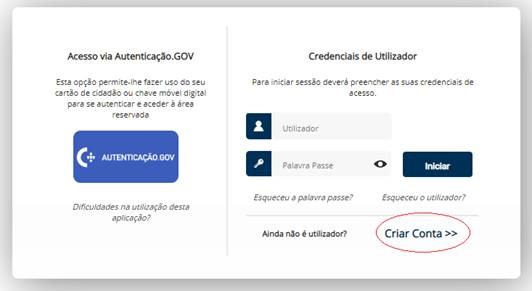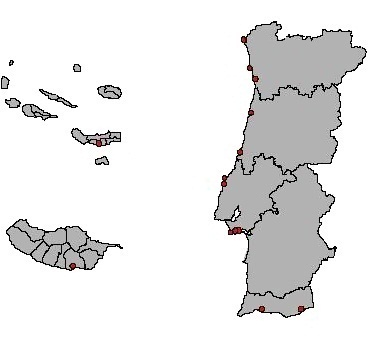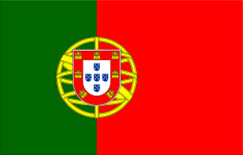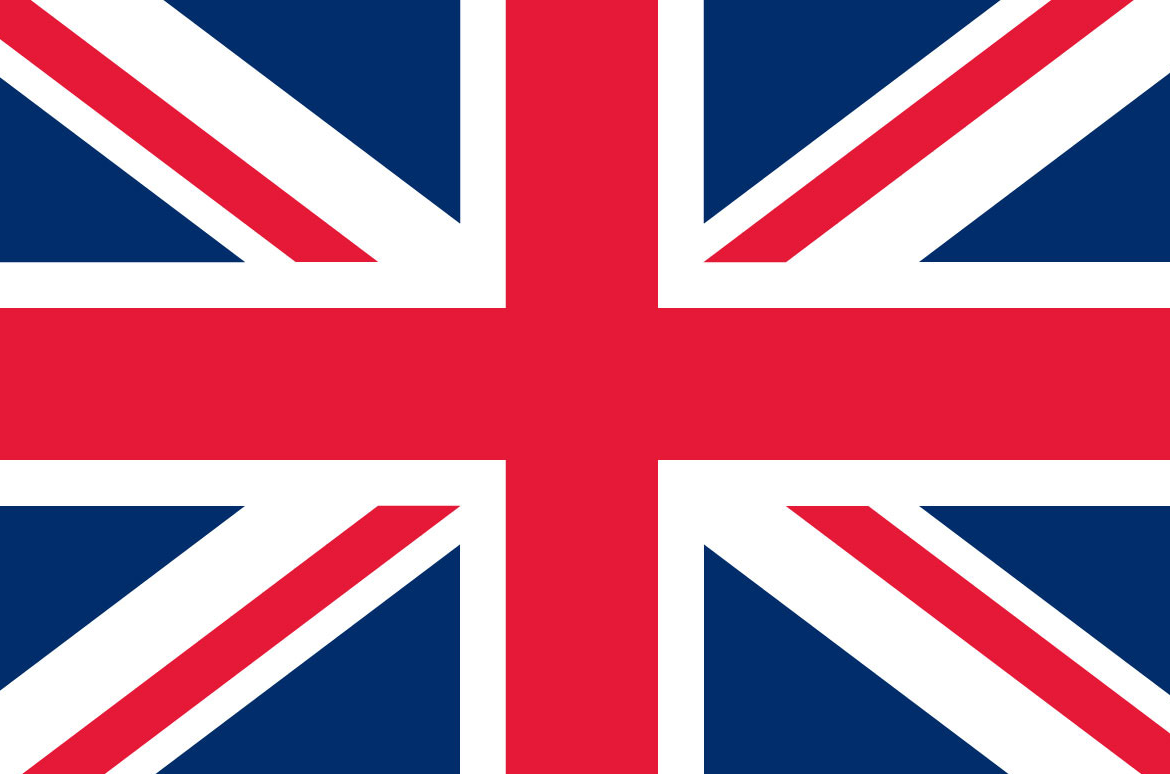Acesso BMar
- Aceder a www.bmar.pt e criar uma conta de utilizador;

2. De seguida, receberá um e-mail com uma ligação para ativar a conta criada (essa ligação só fica válida durante uma hora, pelo que deverá cumprir esse tempo de modo a evitar que o utilizador fique bloqueado);
3. Depois de ativada a conta, deverá ser preenchida toda a informação solicitada e submetidos os dados para ficarem registados no sistema.
Se o seu pedido se encontra em estado “devolvido para aperfeiçoamento”, deverá proceder da seguinte forma:
- Aceder com as suas credenciais a www.bmar.pt;
- No Menu clicar em “Meus Pedidos”;
- Colocar o n.º do pedido (PT………….) e clicar em pesquisar;
- Selecionar o pedido (que ficará marcado a amarelo) e clicar no botão “Aperfeiçoar”;
- Já dentro do pedido, deve efetuar as alterações solicitadas;
- Avançar até ao término do pedido e submetê-lo.
Todas as taxas da DGRM são emitidas com referência MB, para sua comodidade.
Embarcações de Recreio
Neste momento, não existe ainda um pedido especifico para a situação que refere, pelo que deverá submeter um pedido de reserva de nome e número.
No Formulário M_DSAM-119 deverá indicar “Alteração de: “Modificações da Embarcação”".
No passo 3 do pedido no Bmar, no campo “observações” deverá indicar as informações solicitadas sobre o(s) motor(es), bem como anexar o documento comprovativo da respetiva compra, com indicação da marca, do modelo, da potência e do número de série.(Conforme alínea g) do n.º3 e alínea e) do n.º4 do art. 17, DL 93/2018), e dos restantes documentos mencionados nos casos aplicáveis.
De acordo com DL 93/ 2018, uma alteração de motor corresponde a um pedido de modificação, havendo lugar à emissão de uma licença de modificação (artigo 5.º n.º 1 alínea c).
Após modificação, é emitido novo livrete pela Capitania.
Na retoma de um motor deverá existir sempre um documento correspondente à aquisição do mesmo. Sendo posteriormente revendido, deverão ter cópia de todos os documentos, bem como dos respetivos comprovativos.
Nas substituições de motor deverão sempre ser associados os documento comprovativos da respetiva compra conforme alínea g) do nr.º 3 do art.º 17.º do DL 93/2018.
A assinatura do documento deve ser a do requerente do pedido no Bmar, o qual é identificado no acesso ao sistema.
Caso o requerente não seja o titular do pedido de registo / alteração, o sistema exige que seja submetido uma procuração conforme modelo, tal como previsto no Código do Procedimento Administrativo, DL n.º 4/2015, de 07 de Janeiro.
Os prazos para todos os procedimentos administrativos estão previstos no Código do Procedimento Administrativo, DL n.º 4/2015, de 07 de Janeiro.
Todavia, devido ao afluxo de trabalho existente nesta época e às medidas de contingência definidas em sede da Pandemia COVID-19, verifica-se que, em determinadas situações pontuais, possa haver alguns atrasos.
Náutica de Recreio
A sua carta está válida até que complete os 70 anos de idade. Deverá, 30 dias antes da caducidade do título, ser iniciado o processo de renovação, no BMar.
Ao abrigo do novo Regime Jurídico da Náutica de Recreio (Decreto- Lei n.º 93/2018, de 13 de novembro), para a equiparação de carta de navegador de recreio (mais informações aqui) deverá anexar todos os documentos (comprovativos da formação ou categoria profissional) que considerar pertinentes.
Por favor consulte aqui
O atual diploma define que as cartas válidas a 14 de novembro de 2018 se mantêm válidas até que o seu titular complete a próxima idade de renovação, independentemente da validade que está inscrita no cartão atual.
Deverá submeter nova fotografia com fundo obrigatoriamente branco, dimensão semelhante à do cartão do cidadão, onde os olhos deverão estar colocados na linha média da fotografia.
Para saber como aperfeiçoar o seu pedido clique aqui.
Meios Portuários de Receção de Resíduos
A instalação e utilização de meios portuários de receção de resíduos gerados em navios e de resíduos da carga, é regulada pelo Decreto-Lei n.º 165/2003, de 24 de julho, alterado pelo Decreto-Lei 197/2004, de 17 de agosto, pelo Decreto-Lei 57/2009, de 3 de março e pelo Decreto-Lei 83/2017, de 18 de julho.
A partir de 1 de julho de 2021, o Decreto-Lei n.º 165/2003, de 24 de julho, na sua atual redação será revogado pelo Decreto-Lei n.º 102/2020, de 9 de dezembro.
A obrigatoriedade de submissão de PRGR aplica-se a todos os portos nacionais escalados por navios, ou em que operem navios, incluindo embarcações de pesca e de recreio, qualquer que seja o seu pavilhão, com exceção dos navios de guerra, das unidades auxiliares de marinha e dos navios que, sendo propriedade de um Estado ou estando ao seu serviço, sejam utilizados unicamente para fins de serviço público não comercial.
O PRGR deverá ser submetido à Direção Geral de Recursos Naturais, Segurança e Serviços Marítimos (DGRM), pelas autoridades portuárias, ou pelas entidades gestoras de infraestruturas portuárias, conforme aplicável.
O PRGR, incluindo todos os elementos complementares considerados relevantes (e.g. plantas, regulamentos internos, fotografias, etc.), deverá ser submetido à DGRM através do Balcão Eletrónico do Mar (BMar), disponível em: https://www.bmar.pt
O PRGR deverá ser submetido à DGRM para aprovação no prazo de 90 dias antes do término de cada ciclo trienal, e, independentemente do período decorrido, sempre que tenham ocorrido mudanças significativas no funcionamento do porto.
As mudanças significativas referidas no parágrafo anterior podem incluir, entre outras, mudanças estruturais do tráfego no porto, desenvolvimento de novas infraestruturas, alterações na procura e na disponibilização de meios de receção de resíduos, bem como o surgimento de novas técnicas de tratamento a bordo.
Pela apreciação e aprovação do PRGR é cobrada uma taxa prevista no Anexo I, secção XIX da Portaria n.º 342/2015 de 12 de outubro, automaticamente atualizada, com base na variação do índice médio de preços no consumidor no continente, excluindo a habitação, publicada pelo INE, com arredondamento à casa decimal imediatamente seguinte, com efeitos a 1 de março de cada ano
O PRGR deverá conter todos os elementos previstos no Anexo I do Decreto-Lei n.º 165/2003, de 24 de julho, na sua atual redação.
No decurso da avaliação do PRGR e de todos os elementos complementares submetidos, a DGRM pode realizar um pedido de elementos para esclarecimentos adicionais ou envio de documentos considerados necessários ao processo de decisão.
O pedido de elementos é realizado via BMar e a sua resposta deverá ser submetida à DGRM no prazo de 10 dias, igualmente via BMar.
O PRGR é aprovado no prazo de 90 dias após o pagamento da taxa devida ao abrigo da Portaria n.º 342/2015 de 12 de outubro.
A existência de um pedido de elementos suspende o prazo para a aprovação do PRGR até receção de resposta ao mesmo.
A ausência de resposta ao pedido de elementos no prazo definido para o efeito implica a não aprovação do PRGR submetido.
A DGRM realiza ações de fiscalização por meio da realização de auditorias aos portos com vista à verificação da implementação dos procedimentos e condições definidas no PRGR previamente aprovado.
Pelas auditorias com vista a fiscalização da implementação do PRGR é cobrada uma taxa prevista no Anexo I, secção XIX da Portaria n.º 342/2015 de 12 de outubro, automaticamente atualizada, com base na variação do índice médio de preços no consumidor no continente, excluindo a habitação, publicada pelo INE, com arredondamento à casa decimal imediatamente seguinte, com efeitos a 1 de março de cada ano.
Organização comum de mercados
The setting of these rules applies to certain species of fresh fish as well as canned sardines, tuna and bonito.
Compliance with the marketing standards becomes imperative, and can only be commercialized becomes imperative for the products in question, and only those that meet the established quality and calibration criteria should be marketed.
This option has a dual utility:
- Define harmonized commercial characteristics for products across the Union, allowing to differentiate common prices for each category of products, so that a price regime can be applied according to market realities
- Contribute to maintaining the quality of the fish, in order to facilitate its disposal.
Producer organizations (POs) are a fundamental component of the common organization of the markets in fisheries and aquaculture products (CMOs), and it is through them that the sector seeks to organize and stabilize the market.
DGRM is the entity that proceeds to recognize or withdraw recognition of POs in Portugal.
It is important that POs take advantage of the sense of collective responsibility and combine individual efforts to achieve common goals in terms of production and activities upstream and downstream. Beneficiaries of this system are member producers, excluding any other agents in the sector. Producers joining a PO is an optional act.
Among the specific activities of POs, production and commercialization plans stand out. POs can also carry out activities related to the conclusion of fish supply contracts, ensure the temporary storage of fishery products and guarantee the outflow of production from their members.
At the same time, POs have different complementary activities, with emphasis on:
- Intermediation in obtaining financial credit and technical support
- Supply of fishing and navigation materials to members
- Ship maintenance and / or repair services
- Operating cold units
- Participation in companies selling or processing fishery products
- Promotion (or collaboration in promotional campaigns) of products of its members.

Given the unpredictability of fishing activities, the temporary storage of fishery products for human consumption contributes to greater market stability and to the valorisation of products, creating, in particular, added value.
This intervention mechanism is applied exclusively by POs and comes into action when the products placed on the first sale reach a threshold price that triggers their operation.
Trigger Prices for 2018
![]() Download (188 KB)
Download (188 KB)
Rules and Criteria
Help Storage Rules and Criteria
Technical and Financial Costs for 2016, 2017 and 2018
![]() Download (36 KB)
Download (36 KB)
Producer organizations (POs) must guide the activities of their members in line with the objectives of the common fisheries policy (CFP) and the common organization of the markets (CMO), favoring the valorisation of catches.
For each fishing campaign, POs must prepare and submit a production and marketing plan to DGRM, specifying the necessary elements in the production schedule, marketing strategy and measures to achieve their objectives. DGRM will approve this plan.
POs must also submit to DGRM, for approval, an annual report of their activities within the scope of the production and marketing plan, thus evaluating its effectiveness.
A: The PO can allocate personnel expenses, including those mentioned above, in the preparation and execution of the PPC. However, you must indicate a percentage (%) adjusted to the time that was actually spent by the employees and performed tasks within the scope of the respective PPC.
Q: What documentation / proof will be required by DGRM / AG to justify the assignment of these workers to the PPC for each year?
A: The PO must prove the employees' bond. For the purpose of justifying the respective PO, a statement or table referring to the% of allocation of costs incurred with personnel is sent. In terms of personnel costs, the corresponding proof of expenditure must be presented in due course by the PO in connection with the request for payment of support.
Q: The consumables (reams of paper, ink cartridges, toners), as well as the maintenance or purchase of a printer or photocopier, which are used throughout the year due to the PPC in which way can they be charged?
A: With regard to consumables, the PO must likewise allocate to PPPs, a% of the global expenditure on these goods. For this purpose, you must prove with the expense document the acquisition of said consumables and, in the document itself, indicate the respective imputation rate. Regarding the purchase of a printer or photocopier, they may be eligible, provided their need to demonstrate the tasks under the PCC is demonstrated.
Q: Regarding the purchase of consumable goods, is it better to present several invoices or purchase a reasonable quantity at the beginning of the year (in a single invoice) and allocate to the PPC right away?
A: We leave it to the OP's discretion as long as the expense is attributable to the preparation and execution of the PPC for year x and is duly proven.
Q: Are travel expenses for meetings to deal with issues related to the implementation of measures or actions provided for in the PPC, eligible?
A: They are eligible as long as they are included in the PPC and duly proven in the respective Activity Report (AR), as well as the entity (ies) involved and the object of the meeting are identified. The supporting document must be a map on OP letterhead, dated and signed. This map must contain the employee's identification, the number of Km, the unit cost of the km (according to the tables adopted for State employees), the total amount and the identification of the meeting or event to which it refers, must attach the document of the event or summons to the meeting. When requesting payment, the PO must register the statement of expenditure at full cost as proof of expenditure.
Q: As part of the “improvement of the economic profitability” of the members of a PO, the respective strategy involves the purchase of fish in Lota, from the vessels that are members of the PO, destined for a processing establishment (for example, canning factory…). Is the purchase of these species at auction supported?
A: No. Expenses that aim at the identified objective may be eligible, but not the cost of purchasing the fish, as it will later be marketed.
Q: Are production and packaging costs also eligible?
A: No.
Q: Can the measures foreseen in the PPC that relate to investments in other support schemes under the PO Mar 2020 support, regulated by specific ordinances, be supported under the regulation of the PPC support regime?
A: Support for investments for which a specific PO Mar 2020 regime is available must be submitted under the regime to which they relate, although they must be referenced in the PPC.
Q: An investment that aims to meet a certain objective in a given year, within the framework of a PPC, can be made in another year, (depending on financial availability), since the application is multi-annual?
A: The PO can achieve objectives through multiannual execution measures (to be indicated in the PPC), however, it must prove the execution of the annual installment in the respective Activity Report. Measures of an annual nature or the annual installment of a measure must be carried out in the year to which they relate and be confirmed (with expense documents, if applicable) in the respective Activity Report. Expenditure documents are also indispensable for co-financing the amounts presented in the respective applications.
Q: In the expenses already incurred and paid, should budgets be included or in these cases, just present the invoices?
A: With invoices, budgets are not necessary, and a copy of the invoices can be integrated into the application.



